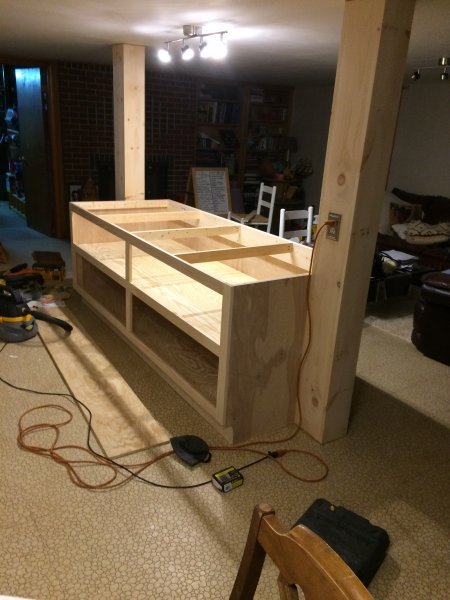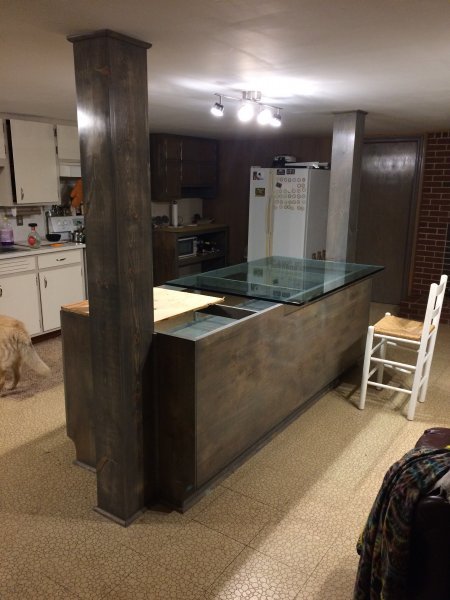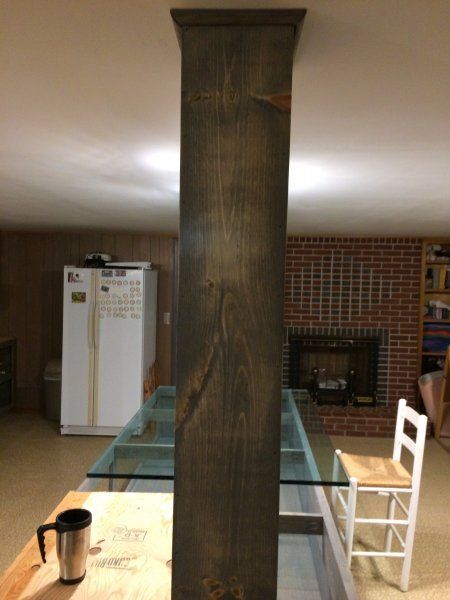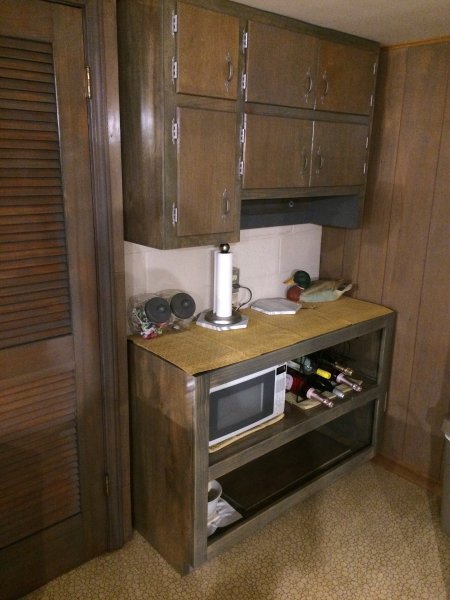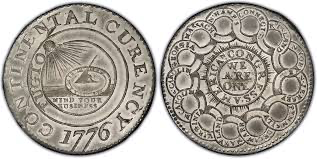COMANCHE, THAT IS BEAUTIFUL. WHAT ARE YOU USING IT FOR?View attachment 1122389 Here's some birch plywood I got at Home Depot.
I used minwax classic gray stain then sanded it down after it dried a couple days.
I sanded it to make sure the woodgrain popped.
From there I used a few coats of minwax poly Clear wiped on and sanded and steel sanded between coats with 220 grit and steel wool.
Lastly I used two coats of some high gloss Watco clear poly
Rubbed on with a rag and it's mirror finish.
The grain is beautiful.
I'm gonna do a small test piece after it dries to the point where the poly has no smell any longer then use a buffing pad with polishing compound on my random orbital sander.
Some guys use the pumice powder and or wet sanding before polishing but it's only recommended if you have multiple coats of poly.
Navigation
Install the app
How to install the app on iOS
Follow along with the video below to see how to install our site as a web app on your home screen.
Note: This feature may not be available in some browsers.
More options
-
ODT Gun Show & Swap Meet - May 4, 2024! - Click here for info
You are using an out of date browser. It may not display this or other websites correctly.
You should upgrade or use an alternative browser.
You should upgrade or use an alternative browser.
question for wood workers
- Thread starter seanc770
- Start date
COMANCHE, THAT IS BEAUTIFUL. WHAT ARE YOU USING IT FOR?
Thanks man.
The wood in pic is the back of a large bar I made in the basement.
I made a baby version of it for a microwave/small cabinet, and an overhead cabinet to match.
Ordering the granite tops soon in India blue which is more gray/white.
Pics don't do these justice and the crap o have on the tops are just temporary until my granite comes.
The big bar was built because my wife wanted me to cover the two ugly Metal beam poles so I suggested a bar between them after boxing them in.
I wanted to put doors on the bar and small cabinet but my daughter and wife wanted them open for easy access to pots and pans.
One side of the bar will be cooking stuff and the other for adult beverages.
The bar will have a granite 12" overhang on the back side for bar flys.
Attachments
Linseed oil is great but if you soak a bunch of paper towels in linseed oil and then tie them up in a plastic trash bag in a hot workshop room they can combust hours later. Really.
All good advice here, but to me, the underlying truth with regard to finishing is that 90% of a successful and durable finish is in the preparation.
Whatever wood you are finishing, it must at least be dry enough inside, to be at equilibrium with the environment. Regardless, even though dry, unless is it perfectly sealed (is there such a finish), seasonal changes in humidity, will cause a slab such as yours to swell and shrink across the grain, perhaps as much as an inch or so.
Try a sharp hand-plane on a small area on the slab, followed by a properly sharpened hand scraper for a cut-finish look.
Whatever wood you are finishing, it must at least be dry enough inside, to be at equilibrium with the environment. Regardless, even though dry, unless is it perfectly sealed (is there such a finish), seasonal changes in humidity, will cause a slab such as yours to swell and shrink across the grain, perhaps as much as an inch or so.
Try a sharp hand-plane on a small area on the slab, followed by a properly sharpened hand scraper for a cut-finish look.
Very nice!!View attachment 1122389 Here's some birch plywood I got at Home Depot.
I used minwax classic gray stain then sanded it down after it dried a couple days.
I sanded it to make sure the woodgrain popped.
From there I used a few coats of minwax poly Clear wiped on and sanded and steel sanded between coats with 220 grit and steel wool.
Lastly I used two coats of some high gloss Watco clear poly
Rubbed on with a rag and it's mirror finish.
The grain is beautiful.
I'm gonna do a small test piece after it dries to the point where the poly has no smell any longer then use a buffing pad with polishing compound on my random orbital sander.
Some guys use the pumice powder and or wet sanding before polishing but it's only recommended if you have multiple coats of poly.
The guys are right, you shouldn't mix oil and water based finishes. If you are going use an oil based stain use an oil based poly over the top of it. If you have your heart set on a water based protection layer use a water based stain. Any way you travel, since this will be a table top, make sure it is properly dried and use mechanical bonds to the frame that allow for some movement (like those little steel figure 8's).
There are trade offs to each finish type. Shellac is easy to apply, cheap, and "builds" thickness the more layers you put on. On the down side, alcohol will kill it. If you want maximum physical protection so with a heavy Poly finish or an epoxy based pour on. High traffic, alcohol present, epoxy is as someone else listed, "bomb proof". On the down side it's a bit more troublesome to apply and when it does get scratched up, it's harder to clean up without sanding it back down to bare wood and starting over. Shellac on the other hand, you can slap on a new layer after some light sanding.
Lots to think about! I build guitars and ukes which are at the end of the day just specialized wood boxes. I do occasionally build other furniture though and most often use a poly or a tinted poly since they are readily available, easy to apply, cheap, and wear pretty well once you get a couple coats on. For guitar work it's almost always shellac or lacquer though.
There are trade offs to each finish type. Shellac is easy to apply, cheap, and "builds" thickness the more layers you put on. On the down side, alcohol will kill it. If you want maximum physical protection so with a heavy Poly finish or an epoxy based pour on. High traffic, alcohol present, epoxy is as someone else listed, "bomb proof". On the down side it's a bit more troublesome to apply and when it does get scratched up, it's harder to clean up without sanding it back down to bare wood and starting over. Shellac on the other hand, you can slap on a new layer after some light sanding.
Lots to think about! I build guitars and ukes which are at the end of the day just specialized wood boxes. I do occasionally build other furniture though and most often use a poly or a tinted poly since they are readily available, easy to apply, cheap, and wear pretty well once you get a couple coats on. For guitar work it's almost always shellac or lacquer though.
One thing to remember is that BLO is not waterproof. It will stain if it gets seriously wet.
I have done this on a couple or three stocks, something I picked up, and it works well, but takes some time and prep. It's waterproof.
Sand your stock.
Apply pure BLO
Let dry a little, then sand again. This will make a stiff slurry, and as you sand it will fill in any pores.
Wipe with tack rag.
Get a good quality exterior polyurethane. High gloss or matte, l like the matte)
Mix 50/50 BLO and poly, apply, let dry, and then sand.
Mix 76% poly/25% BLO and apply, let dry several days and sand.
Apply 90% poly/10% mineral spirits, let dry and sand with 600 grit sandpaper. Make sure to use a sanding block.
If you want to get really obsessive, after the first two applications, take a spray bottle and spray rubbing alcohol on the stock, let dry (like 30 seconds) then sand. This raises any "hairs" on the stock and you will get a smoother finish.
I have done this on a couple or three stocks, something I picked up, and it works well, but takes some time and prep. It's waterproof.
Sand your stock.
Apply pure BLO
Let dry a little, then sand again. This will make a stiff slurry, and as you sand it will fill in any pores.
Wipe with tack rag.
Get a good quality exterior polyurethane. High gloss or matte, l like the matte)
Mix 50/50 BLO and poly, apply, let dry, and then sand.
Mix 76% poly/25% BLO and apply, let dry several days and sand.
Apply 90% poly/10% mineral spirits, let dry and sand with 600 grit sandpaper. Make sure to use a sanding block.
If you want to get really obsessive, after the first two applications, take a spray bottle and spray rubbing alcohol on the stock, let dry (like 30 seconds) then sand. This raises any "hairs" on the stock and you will get a smoother finish.
This ^......end of story......Crystal Clear Bar Table Top Epoxy Resin
Similar threads
- Replies
- 5
- Views
- 364




